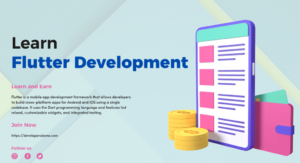Flutter is an open-source framework developed by Google that allows developers to create high-performance, visually appealing, and natively compiled applications for mobile, web, and desktop platforms. One of the most popular classes in Flutter is the MaterialApp class, which simplifies the app development process and enhances the user experience.
In this blog post, we will discuss the MaterialApp class in Flutter, its features, benefits, and how to use it in your app development process.
Contents
What is the MaterialApp class in Flutter?
The MaterialApp class is a pre-built widget in Flutter that provides a basic structure for a Material Design app. It is a top-level widget that provides a scaffold for your app and includes various features such as navigation, theming, and localization.
What are the features of the MaterialApp class?
The MaterialApp class includes several features that make it a popular choice for app development, including:
- Navigation – The MaterialApp class includes a navigation system that makes it easy to manage app routes and transitions between screens.
- Theming – The MaterialApp class provides built-in theming support that allows developers to customize the appearance of their app with ease.
- Localization – The MaterialApp class includes support for localization, making it easy to translate your app into multiple languages.
- Accessibility – The MaterialApp class includes accessibility features that make your app more user-friendly for individuals with disabilities.
What are the benefits of using the MaterialApp class?
There are several benefits to using the MaterialApp class in your Flutter app development process, including:
- Simplified development process – The MaterialApp class provides a basic structure for your app, making it easier to focus on building the features that matter most.
- Consistent design – The MaterialApp class follows Material Design guidelines, ensuring a consistent and familiar user experience across different apps.
- Faster development time – The built-in features of the MaterialApp class reduce the amount of time required for custom implementation and testing.
How do I use the MaterialApp class in my Flutter app?
To use the Material App class in your Flutter app, you need to import the material.dart package and add a Material App widget to your app’s top-level widget tree. Here is an example:
import 'package:flutter/material.dart';
void main() {
runApp(MyApp());
}
class MyApp extends StatelessWidget {
@override
Widget build(BuildContext context) {
return MaterialApp(
title: 'My App',
home: Scaffold(
appBar: AppBar(
title: Text('My App'),
),
body: Center(
child: Text('Hello, World!'),
),
),
);
}
}
In the above example, we have created a basic Material App widget with a title and a Scaffold widget that includes an AppBar and a Center widget with a Text widget.
What are some best practices for using the Material App class?
When using the Material App class in your app development process, it is important to follow these best practices:
- Use proper theming – The Material App class provides built-in theming support, so make sure to use it to customize the appearance of your app.
- Keep the widget tree simple – The Material App class provides a basic structure for your app, but it is important to keep the widget tree simple to avoid performance issues.
- Use the named routes feature – The Material App class includes a named routes feature that makes it easy to manage app routes and transitions between screens.
Conclusion:
The Material App class in Flutter is a powerful tool that simplifies the app development process and enhances the user experience. With built-in features like navigation, theming, localization, and accessibility, it makes it easier for developers to create high-performance, visually appealing, and natively compiled applications for mobile, web, and desktop platforms.
In this blog post, we have discussed the features and benefits of using this class in Flutter, how to use it in your app development process, and some best practices to follow. By implementing the best practices, you can create a consistent and familiar user experience across different apps, reduce development time, and improve the performance of your app.
In summary, the Material App class in Flutter is an essential tool for any developer looking to create beautiful and functional apps. Its built-in features and simplicity make it an excellent choice for both beginner and experienced developers.


